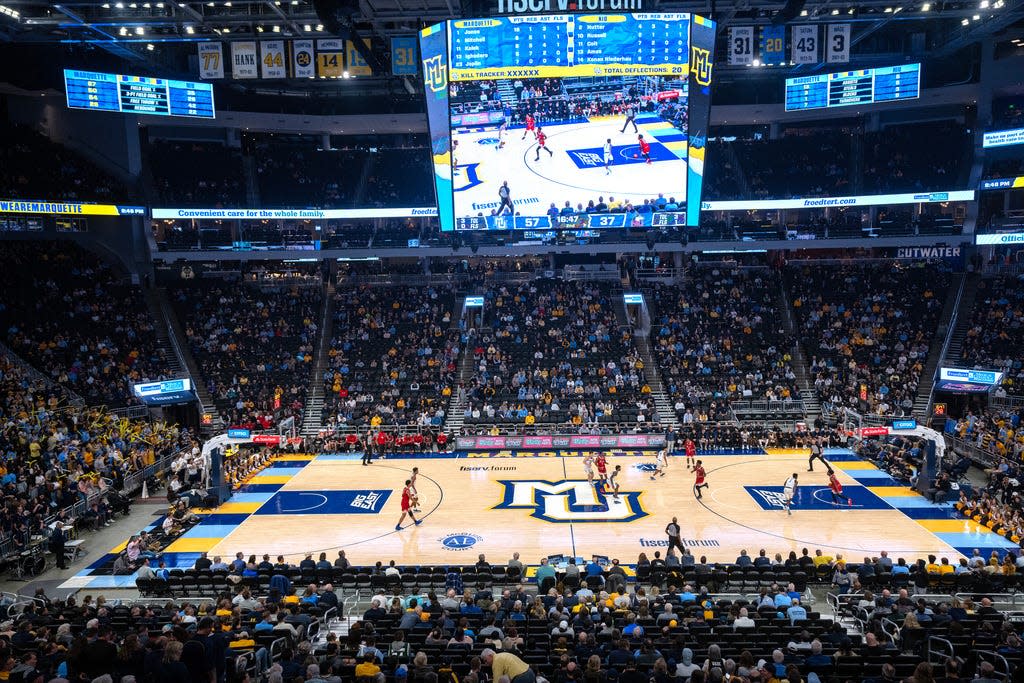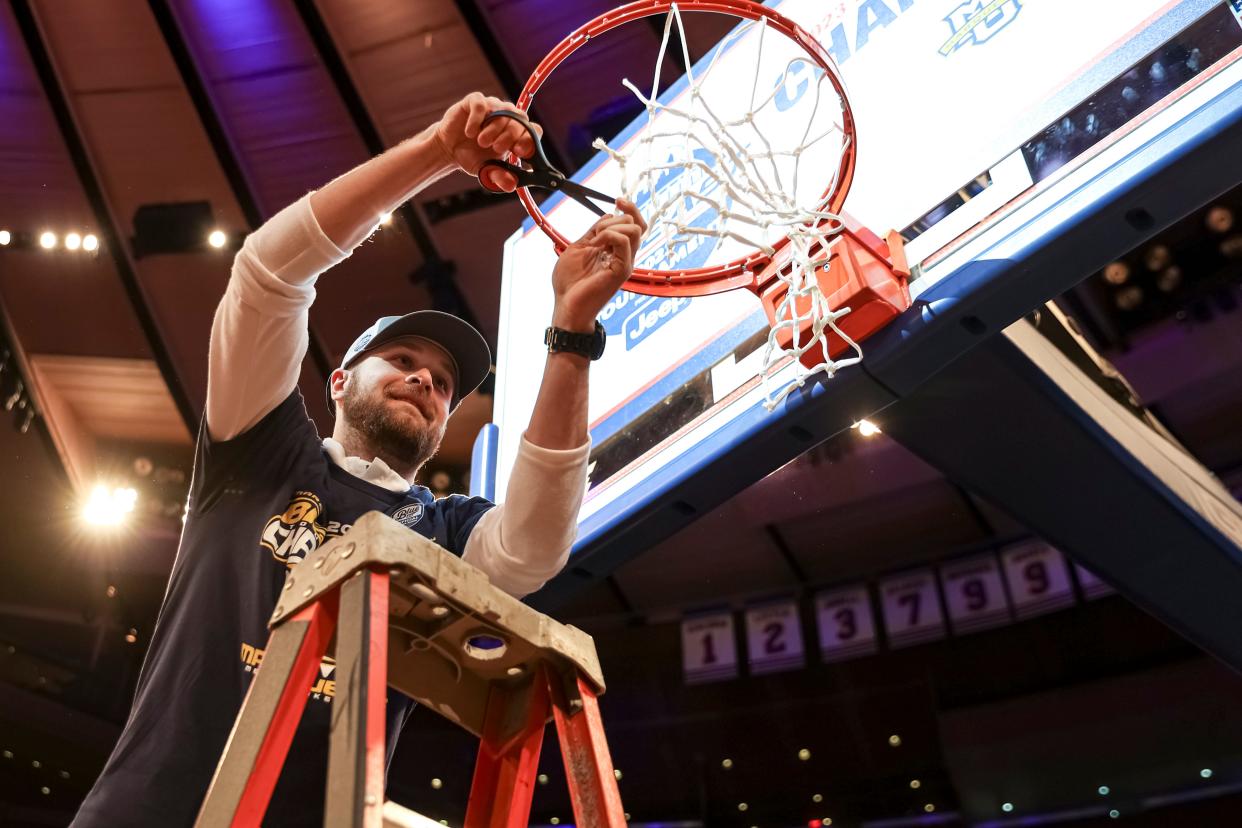Here's the story behind Marquette basketball's new court at Fiserv Forum
There is more than meets the eye when it comes to the changes to the new court at Fiserv Forum for the Marquette men's basketball team.
The subtle changes to the design reflect the bigger picture that Golden Eagles head coach Shaka Smart wants others to see.
The Golden Eagles are 1-0 on the new playing surface heading into Friday night's matchup with Rider (1-0). The biggest change from last season is the blue-and-gold piping on the baseline, a nod to the program's long history of unique uniforms.
That was an easy homage, according to MU assistant athletic director for basketball Ben Retzlaff, who had a hand in designing the court.
"One of the emphases Coach had last spring was building on this idea of blending past and present," Retzlaff said. "And then also messaging that to our future.
"So when you think of messaging, we want to message our current players, our former players and the players that will be a part of this program."
The fifth-ranked Golden Eagles feel capable of having a special season. While wanting this team to make its own history, Smart has made sure to stay engaged with the century-old legacy of the program. There was a callout on social media in September for any former MU player to attend practices at the Al McGuire Center. The team that reached the 1974 Final Four will be celebrated at a game this season.
“Honoring the past and bringing it to the present moment of the floor we’re playing on," Retzlaff said. "So that was the thinking there."

Marquette also will spotlight honored numbers
The piping isn't the only part of the floor that honors MU's past.
On the sideline where Smart often stands during games near the team's bench, there are logos with the honored jersey numbers of the school's all-time great players: 3 (Dwyane Wade), 14 (Dean Meminger), 15 (Butch Lee), 20 (Maurice Lucas), 24 (George Thompson), 31 (Bo Ellis and Glenn "Doc" Rivers), 43 (Earl Tatum) and 44 (Don Kojis).
Eventually there will be a spotlight in the arena with a "Championship Blue" hue that highlights those numbers during the pregame hype videos.
"It’s just one piece into this more holistic idea of that blending of the past, present and future with our program," Retzlaff said of the court.
The part of the court where basketball is actually played remains free of any design flourishes. The coaching staff had input with Retzlaff, who also worked with senior associate athletic director for communications Scott Kuykendall and assistant athletic director for game presentation and fan experience Brian Begley on the new court. The coaches didn't want a busy surface, meaning no full-color two-point area and definitely nothing like the NBA's wild In-Season Tournament courts.
“It was keep the playing surface clean and let’s get creative on the skirt area on the outside," Retzlaff said.
There were some color changes. The free-throw lanes are blue and the MU logo at center court has gone from gold to white.
"That was a little stylistic change," Retzlaff said. "I think, and this is just my personal opinion and other people may share it, that you can go a lot wrong faster than you can go right in floor design."

Ben Retzlaff has blend of basketball and design skills
Retzlaff's history is interesting.
He was an all-state guard and led Chippewa Falls McDonell Central to the 2016 WIAA Division 5 state championship. He played one season at St. Norbert.
“My senior year I was top-three in the state in shooting, 101 three-pointers," Retzlaff said. "I was only 6-1, 155 though, so as it translated to the collegiate level it was a bit different. Hence why I only played one year."
He still had a passion for sports, but transferred to UW-Eau Claire and became a student coach. He also spent late nights at the library teaching himself editing programs like Photoshop and Premiere Pro.
"I had heard especially with mid-major programs there was a real need for people to do graphics," Retzlaff said. "But there was a disconnect because a lot of people that wanted to get into those lower positions solely had a desire to coach and they overlooked some of these technical skills.”
Retzlaff landed a job as a graduate assistant at Louisiana Tech under Eric Konkol, a former UW-Eau Claire player. Konkol, now the head coach at Tulsa, knew that Retzlaff wanted to get back home to Wisconsin, so when Smart was forming his staff Konkol put in a good word with Smart and MU assistant coach Neill Berry.
“He’s incredibly important to our team," Smart said. "Wears a lot of hats. We brought him in here originally to make graphics. Make content and create content for our team to utilize in recruiting and with our current program.
"His role has really evolved because he’s very, very valuable. He’s got a strategic mind. He understands culture."
During games, Retzlaff is on the bench holding Smart's "Circle," which displays Smart's key tenets. He also helps track Smart's valued "EGBs" – energy generating (or giving) behavior – and makes sure the totals are correct on Fiserv's video boards.
That's all a part of Smart's visual approach.
"Coach’s original thought was this stuff goes into winning," Retzlaff said. "It’s an untapped resource that we have here that we wanted to grow. An engaged fan base and student section, a utilization of the technology we have available at Fiserv. It can help you win games.
“Like when you’ve got Coach Smart cued up on the JumboTron yelling “Kill Zone” when we need one more (defensive) stop. And then the fans get on their feet and are juiced. You can’t tell me that’s not a competitive advantage.
"Literally every piece visually and messaging is funneled into this greater idea. Like the floor, it was just saying, OK, how does it fit in with what we’re trying to do? A great intentionality and a detailed approach to it. It’s not like, ‘Oh, these colors look cool. Let’s throw it on.’ ”
This article originally appeared on Milwaukee Journal Sentinel: Marquette basketball staff member Ben Retzlaff helped design new court
